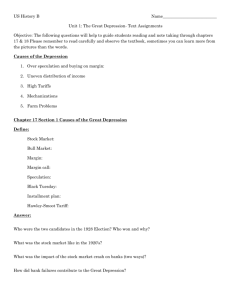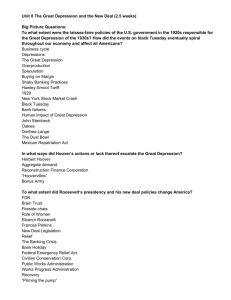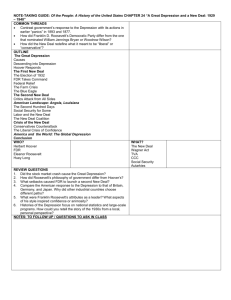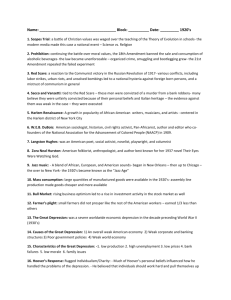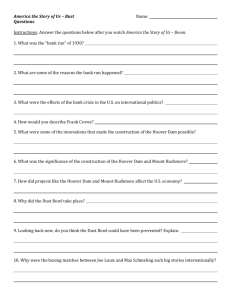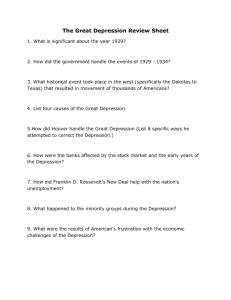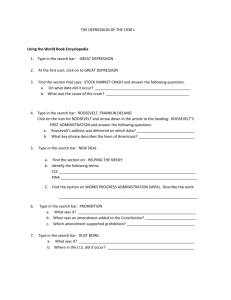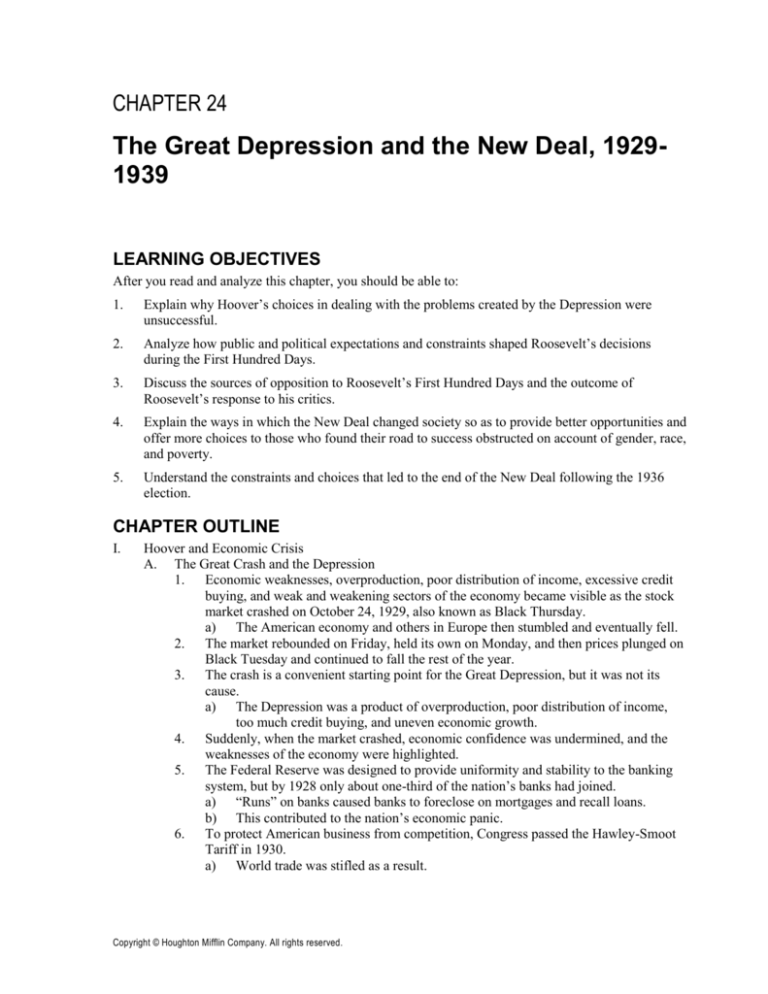
CHAPTER 24
The Great Depression and the New Deal, 19291939
LEARNING OBJECTIVES
After you read and analyze this chapter, you should be able to:
1.
Explain why Hoover’s choices in dealing with the problems created by the Depression were
unsuccessful.
2.
Analyze how public and political expectations and constraints shaped Roosevelt’s decisions
during the First Hundred Days.
3.
Discuss the sources of opposition to Roosevelt’s First Hundred Days and the outcome of
Roosevelt’s response to his critics.
4.
Explain the ways in which the New Deal changed society so as to provide better opportunities and
offer more choices to those who found their road to success obstructed on account of gender, race,
and poverty.
5.
Understand the constraints and choices that led to the end of the New Deal following the 1936
election.
CHAPTER OUTLINE
I.
Hoover and Economic Crisis
A. The Great Crash and the Depression
1. Economic weaknesses, overproduction, poor distribution of income, excessive credit
buying, and weak and weakening sectors of the economy became visible as the stock
market crashed on October 24, 1929, also known as Black Thursday.
a) The American economy and others in Europe then stumbled and eventually fell.
2. The market rebounded on Friday, held its own on Monday, and then prices plunged on
Black Tuesday and continued to fall the rest of the year.
3. The crash is a convenient starting point for the Great Depression, but it was not its
cause.
a) The Depression was a product of overproduction, poor distribution of income,
too much credit buying, and uneven economic growth.
4. Suddenly, when the market crashed, economic confidence was undermined, and the
weaknesses of the economy were highlighted.
5. The Federal Reserve was designed to provide uniformity and stability to the banking
system, but by 1928 only about one-third of the nation’s banks had joined.
a) “Runs” on banks caused banks to foreclose on mortgages and recall loans.
b) This contributed to the nation’s economic panic.
6. To protect American business from competition, Congress passed the Hawley-Smoot
Tariff in 1930.
a) World trade was stifled as a result.
Copyright © Houghton Mifflin Company. All rights reserved.
302
Chapter 24: The Great Depression and the New Deal, 1929-1939
B.
II.
Hoover and the Depression
1. Secretary of Treasury Andrew Mellon voiced the prevalent sentiment that the economy
remained strong and the market plunge was only temporary.
2. Most experts believed the government should let the economy heal itself.
a) President Hoover worked with the Federal Reserve System to expand credit and
urged Congress, states, and cities to increase spending on public works projects.
3. With the economy slipping further, Hoover took new steps in 1931.
a) He asked Congress for banking reforms, financial support for home mortgages,
the creation of the Reconstruction Finance Corporation, and higher taxes to pay
for it all.
b) Congress responded with the Glass-Steagall Banking Act, the Federal Home
Loan Act, and the RFC.
4. Hoover opposed direct federal relief to the poor, believing it would be too expensive
and, even worse, erode the work ethic.
5. Many Americans blamed the president and the Republicans for the worsening
economy and a callousness toward the hardships faced by many Americans.
a) In the traditional conservative farm belt, militant farmers joined the Farmers’
Holiday Association led by Mile Reno.
(1) Reno called on farmers to resist foreclosures and to destroy their crops.
b) A large expression of protest took place in Washington, D.C., as thousands of
WWI veterans, called the Bonus Army, converged to support the “bonus bill”
that would provide them with an early payment of their veteran’s bonus.
The New Deal
A. Roosevelt Confronts the Depression
1. Roosevelt and his Brain Trust had no clear plan to restore prosperity despite the
public’s perception that they did.
2. On March 6, 1933, Roosevelt declared a national Bank Holiday that closed the
country’s banks.
3. Three days later, the president presented the Emergency Banking Bill.
4. On March 12, Roosevelt held one of his first fireside chats.
5. Roosevelt signed 15 major pieces of legislation over the next 100 days.
a) The legislation was moving along three paths: recovery, relief, and reform.
B. Seeking Recovery
1. Passed by Congress on May 12, the Agricultural Adjustment Administration
encouraged farmers to reduce production by paying them not to plant.
a) Farmer approval of the AAA remained high even as the Supreme Court declared
that it was unconstitutional in Butler v. the United States.
b) Undeterred, the administration used other programs, such as the Soil
Conservation Act, to reduce production.
2. As the Dust Bowl reached its worst, Congress approved a second AAA that
reestablished the principle of federally set commodity quotas, acreage reduction, and
parity payments.
3. The National Industrial Recovery, approved in June 1933, created the National
Recovery Administration for long-term economic revival and the Public Works
Administration for more immediate work relief.
a) The NRA implemented codes that established prices, production levels, and
wages.
b) Labor was attracted by pro-labor codes (Section 7a) that gave workers the right to
organize and bargain collectively, outlawed child labor, and established
minimum wages and maximum hours of work.
Copyright © Houghton Mifflin Company. All rights reserved.
Chapter 24: The Great Depression and the New Deal, 1929-1939
c)
C.
D.
303
In 1935, Schechter Poultry Corporation v. the United States held that the
government could not set national codes or wages and hours in local plants.
4. Perhaps the most innovative and successful recovery program was the Tennessee
Valley Authority.
a) Hundreds of miles of river and lakes were made more navigable, soil erosion was
reduced, and TWA dams provided electricity.
b) The Roosevelt administration committed itself to the electrification of rural
America through the Rural Electrification Administration.
(1) The electrification of rural America helped integrate those areas with the
culture of modern urban America.
Remembering the “Forgotten Man”
1. The Civilian Conservation Corps (CCC) established army-style camps to house and
provide a healthy, moral environment for unemployed urban males aged 18 to 25.
2. The Federal Emergency Relief Administration (FERA), along with the PWA, provided
a wider range of relief programs for the “forgotten man.”
3. The Civil Works Administration (CWA) provided nearly four million immediate jobs,
especially during the winter of 1933-1934.
4. The Home Owner’s Loan Corporation (HOLC) permitted homeowners to refinance
their mortgages at lower interest rates through the federal government, and the Federal
Housing Administration (FHA) provided federally backed loans for home mortgages
and repair.
Changing Focus
1. The New Deal started with almost total support, but as proposals flowed from the
White House and the economy improved, opposition emerged.
a) Conservatives fumed that Roosevelt threatened free enterprise, if not capitalism.
b) For the majority of the American people, however, Roosevelt and the New Deal
still spelled hope and faith in the future.
2. Three critics were especially popular.
a) Father Charles Coughlin formed the National Union for Social Justice, which
advocated a guaranteed annual income, the redistribution of national wealth,
tougher antimonopoly laws, and the nationalization of banking.
b) Senator Huey Long of Louisiana advocated a Share the Wealth plan, which
called for the federal government to provide every American family with an
annual check for $2,000, a home, a car, a radio, and a college education for each
child.
c) Dr. Francis Townsend, a public health doctor, advocated a federal old-age
pension plan.
3. The national codes of the NRA had raised workers’ expectations by promoting unions
and establishing higher wages.
a) As workers became more dissatisfied with the application of NRA codes, a more
militant and political worker emerged.
4. Responding to the growing pressures to modify the New Deal and showing his
irritation with business leaders, Roosevelt focused more on people than on business
beginning in 1935 and targeted under-consumption rather than low production.
a) Congress allocated nearly $5 billion for relief to be divided among the CCC,
PWA, FERA, and the newly created Works Progress Administration (WPA).
b) Most WPA workers did manual labor, but the WPA also employed professional
and white-collar workers.
c) The WPA made special efforts to help women, minorities, students, and young
adults.
Copyright © Houghton Mifflin Company. All rights reserved.
304
Chapter 24: The Great Depression and the New Deal, 1929-1939
5.
The National Youth Administration (NYA) provided aid for college and high school
students and programs for young people not in school.
6. The Social Security Act established a federal old-age and survivor insurance program
that was to be a permanent modification of the government’s role in society.
7. The National Labor Relations Act, or Wagner Act, strengthened the union movement
by putting the power of government behind the workers’ right to organize and to
bargain with employers for wages and benefits.
E. Waning of the New Deal
1. To alter the political philosophy of the Court and to protect programs that had already
been passed, Roosevelt wanted to appoint enough new justices to ensure a pro-New
Deal majority.
a) Roosevelt made a major political miscalculation with his Court-packing plan, and
he lost the loyalty of many Democrats who now sided with the Republicans.
b) Roosevelt eventually admitted defeat and dropped the issue, but not after
squandering a great deal of his political assets.
2. By 1937, Roosevelt and the New Deal legislation faced an increasingly hostile political
environment as a growing number of moderates joined conservatives in viewing
Roosevelt as too radical and anti-business.
3. The Fair Labor Standards Act—which established an initial maximum workweek of 44
hours, set a minimum wage of 25 cents an hour, and outlawed child labor under age
16—was the last piece of New Deal legislation.
III. Surviving the Depression
A. Coping with the Depression
1. Magazines and newspapers provided useful hints and “Depression recipies.”
2. Most towns and cities had little ability to provide more than the smallest amount of
relief.
a) Unsuccessfully struggling to maintain basic city services.
B. “Making Do” - Families and the Depression
1. “Use it up, wear it out, make it do, or do without” became the motto of most American
families.
a) Feed sacks became a source of material.
2. Many families, however, still failed, losing first jobs and then homes.
a) Some families “doubled up” and moved in with relatives.
3. Despite the hardships and migrations, American society did not collapse, as some had
predicted.
a) Most families clung tightly to traditional social norms and even expanded family
togetherness.
4. Movies and radio provided a break from the woes of the Depression.
5. Novels, however, were often more critical of American society, culture, and politics.
6. The largest audience was reached by radio.
C. Women and Minorities in the Depression
1. As unemployment rose, so did pressure not to hire women or minorities.
2. Few working women found that bringing home a paycheck changed their status or role
within the family.
3. African Americans, Hispanics, and Asians faced increased racial hostility and demands
that they give up their jobs to whites.
D. A New Deal for Women and Minorities
1. Perhaps even more than the president, Eleanor Roosevelt was sensitive to the needs of
average Americans, especially minorities and women.
a) Rarely able to provide any direct assistance, her message emphasized hope and
explained changes being made by the New Deal.
Copyright © Houghton Mifflin Company. All rights reserved.
Chapter 24: The Great Depression and the New Deal, 1929-1939
305
b)
2.
3.
4.
She publicly and privately worked to reduce discrimination in the government
and throughout the country.
c) Yet the New Deal developed only a few programs for women and frequently paid
women less than men for the same work.
More African Americans than ever before were appointed to government positions.
a) But the Roosevelt administration shrank away from supporting civil rights
legislation.
Mexican Americans benefited from the New Deal in much the same way as African
Americans—indirectly.
American Indians, however, benefited from the Indian Reorganization Act.
IDENTIFICATIONS
Identify the following items and explain the significance of each. While you should include any
relevant historical terms, using your own words to write these definitions will help you better remember
these items for your next exam.
1.
Frances Perkins
2.
Franklin D. Roosevelt
3.
child labor
4.
associationism
5.
Black Thursday
6.
industrials
7.
Great Depression
8.
Brookings Institute
9.
run
10. Hawley-Smoot Tariff
11. public works projects
12. Boulder Dam
13. Reconstruction Finance Corporation
14. Glass-Steagall Banking Act
15. Federal Home Loan Act
16. savings and loan associations
17. direct relief payments
18. Farmers’ Holiday Association
19. Milo Reno
20. foreclosure
21. Bonus Army
22. Hooverville
23. New Deal
24. Brain Trust
Copyright © Houghton Mifflin Company. All rights reserved.
306
Chapter 24: The Great Depression and the New Deal, 1929-1939
25. Bank Holiday
26. Emergency Banking Bill (Act)
27. fireside chats
28. recovery
29. Agricultural Adjustment Act
30. Butler v. the United States
31. Soil Conservation Act
32. Dust Bowl
33. parity
34. National Industrial Recovery Act
35. Public Works Administration
36. National Recovery Administration
37. General Hugh Jackson
38. price fixing
39. juggernaut
40. Schechter Poultry Corporation v. the United States
41. Tennessee Valley Authority
42. Rural Electrification Administration
43. Civilian Conservation Corps
44. Federal Emergency Relief Administration
45. Civil Works Administration
46. chloroform
47. Harold Ickes
48. Home Owners’ Loan Corporation
49. Federal Housing Administration
50. Federal Deposit Insurance Corporation
51. Securities and Exchange Commission
52. Father Charles Coughlin
53. Huey Long
54. Dr. Francis Townsend
55. Share the Wealth
56. United Automobile Workers
57. Congress of Industrial Organizations
58. work relief
59. Works Progress Administration
Copyright © Houghton Mifflin Company. All rights reserved.
Chapter 24: The Great Depression and the New Deal, 1929-1939
307
60. Harry Hopkins
61. National Youth Administration
62. Mary McLeod Bethune
63. Social Security Act
64. Wagner Act
65. blacklisting
66. Alfred Landon
67. Roosevelt’s recession
68. Fair Labor Standards Act
69. relief
70. reform
71. “making do”
72. colonia
73. Scottsboro Nine
74. Black Cabinet
75. private sector
76. Indian Reorganization Act
77. John Collier
MULTIPLE-CHOICE QUESTIONS
1.
2.
3.
4.
All of the following contributed to the coming of the Great Depression EXCEPT
a.
agricultural distress.
b. industrial overproduction.
c.
excessive government regulation.
d. uneven income distribution.
On Black Thursday, October 24, 1929,
a.
stock prices plunged on the New York Stock Exchange.
b. President Hoover declared a national emergency.
c.
grain prices soared on the Chicago Commodities Exchange.
d. poor farmers marched on Washington demanding relief.
Hoover’s plan to fight the depression through the Reconstruction Finance Corporation faltered
a.
because Democrats in Congress refused to cooperate with him for political reasons.
b. because of mismanagement and corruption.
c.
when its board of directors showed great timidity in lending funds at its disposal.
d. after the Supreme Court declared it unconstitutional.
The Bonus Army encampment in Washington, D.C.,
a.
was a public relations disaster for President Hoover.
b. brought public relief for the unemployed.
c.
discredited veterans’ demands for retirement benefits.
d. destroyed the military career of General Douglas MacArthur.
Copyright © Houghton Mifflin Company. All rights reserved.
308
Chapter 24: The Great Depression and the New Deal, 1929-1939
5.
Roosevelt decided to close all banks in the nation when he took office
a.
because of the panic by depositors that threatened to ruin the entire banking system.
b. as a political ploy to create a sense of crisis—which he would then solve.
c.
in order to end installment buying, speculation in stocks, and other excessive reliance on
credit.
d. to emphasize the differences between himself and his predecessor, Herbert Hoover.
6. The Agricultural Adjustment Act (AAA) was aimed at
a.
lowering the cost of farm machinery.
b. stabilizing farm produce prices.
c.
providing work for migrant laborers.
d. ending sharecropping in the South.
7. To stimulate industrial recovery, the New Deal
a.
provided huge cash subsidies for industries that produced consumer goods.
b. suspended antitrust suits against businesses that cooperated with the NRA.
c.
offered incentives to heavy industries to modernize their factories.
d. abolished all corporate income taxes.
8. Opponents of the New Deal
a.
were able to prove that there was widespread corruption and mismanagement in the
Tennessee Valley Authority.
b. found absolutely no support even in the Supreme Court.
c.
sought to discredit it by labeling it “socialist” and “fascist.”
d. accused Roosevelt of immorality and scandalous behavior.
9. The Civilian Conservation Corps and the Public Works Administration were
a.
socialist experiments to reallocate property and resources in the American economy.
b. government agencies whose employees were illegally ordered to support the Democratic
Party.
c.
New Deal initiatives that were struck down by the Supreme Court as unconstitutional.
d. New Deal programs that provided jobs for unemployed individuals.
10. The Share the Wealth plan that proposed a minimum and maximum income for all Americans was
the brainchild of
a.
Eleanor Roosevelt.
b. Huey Long.
c.
Harold Ickes.
d. Father Charles Coughlin.
11. The legislative acts of the Second Hundred Days
a.
were all subsequently declared unconstitutional by the Supreme Court.
b. were designed by Roosevelt to reduce the opposition of the business community to the New
Deal.
c.
made the Depression worse because they unbalanced the federal government’s budget.
d. underscored that the government was now assuming more responsibility for the economic
welfare of the individual citizen.
12. Identifying the causes of the individual’s difficulties, Depression-era authors like Richard Wright
and John Steinbeck
a.
held fast to the traditional view that laziness and weakness of character were what caused
poverty.
b. urged a return to the religious values of an earlier day.
c.
shifted the blame from the individual to society.
d. focused on the disruptive effects of modern technology.
Copyright © Houghton Mifflin Company. All rights reserved.
Chapter 24: The Great Depression and the New Deal, 1929-1939
309
13. African Americans supported Roosevelt
a.
in return for his support of an antilynching bill in Congress.
b. since he was willing to risk losing the support of the South in the name of racial equality.
c.
because they received benefits under New Deal relief programs.
d. because the Republican Party began to make racial and anti-immigrant appeals in efforts to
win elections.
14. The most innovative technique devised by organized labor to oppose management in the 1930s
was the
a.
boycott.
b. picket line.
c.
sympathy strike.
d. sit-down strike.
15. One long-lasting effect of New Deal legislation was to
a.
sharpen the distinction between liberals and conservatives over the role and responsibilities
of government.
b. prove that government could end a depression and otherwise control the direction of the
economy if it chose to.
c.
reinforce the popular view that politicians and government officials could not be trusted.
d. undermine the drive for equality for women and the members of minority communities in
American society.
ESSAY QUESTIONS
1.
Imagine that you are a Democrat running for national office in 1932. What would you choose to
emphasize in your campaign speeches and literature?
DEVELOPING YOUR ANSWER: Presumably, you would choose to attack the Republicans for
causing the Great Depression, for failing to do anything about it, and for not helping the ordinary
person to cope with the difficulties that ensued. Points that you could make would include:
During a decade of Republican rule, nothing was done to prevent unsafe levels of buying on
credit.
There was no recognition of the problem of overproduction in many industries and the weakness it
implanted in the general economy.
Farmers had been allowed to slide into a depression well before the rest of the nation. Not only
did they suffer personally, but their inability to buy goods and services also weakened the
economy.
Once the Depression began, the Republican administration did little to fight it. The Reconstruction
Finance Corporation and the doubling of public works projects proved to be ineffective responses.
(Be sure to explain why they were ineffective.)
Exemplifying the beliefs of the Republicans, President Hoover was reluctant to introduce relief
programs for ordinary people. The RFC did even less in this area than it was legally authorized to
do.
Finally, the attack on unarmed Bonus Marchers in Washington, D.C., by the U.S. Army was a
spectacle too awful to contemplate. Innocent veterans who had fought in World War I and had
come to Washington to express their constitutional right to petition their government were set
upon for no reason.
Copyright © Houghton Mifflin Company. All rights reserved.
310
2.
Chapter 24: The Great Depression and the New Deal, 1929-1939
Millions of voters in the presidential election of 1932 held the Republicans responsible for the
Great Depression and for the suffering it engendered. In your opinion, was it fair of them to do
so?
DEVELOPING YOUR ANSWER: If you argue in the affirmative, then you should stress the
Republicans’ philosophy during the 1920s of minimizing the role of government in solving
economic and social problems. Consequently, they did little about the decline of purchasing
power among farmers that preceded and contributed to the Great Depression and nothing about
falling consumption. At the time of the great crash on Wall Street, they left it to the financial
community to try to stem the tide; when the bankers were unable to do so, the government did not
step in. As if pouring oil on a fire, the Republicans in Congress insisted on enacting the HawleySmoot Tariff eight months after Wall Street’s debacle.
To add to your analysis of why the Republicans should be held accountable, you should also
emphasize the limited action taken by the Hoover administration. This, of course, goes back to the
Republicans’ views about the government’s role. Hoover opposed relief for the poor and
unemployed. He hoped that the Reconstruction Finance Corporation would restore the economy.
But when this did not work as planned, nothing else was tried. Indeed, the RFC could lend money
to the states to provide relief for impoverished individuals, but it timidly held back from doing so.
If, on the other hand, you choose to argue that it was inappropriate to hold the Republicans
responsible, then you can argue that they were hardly the only ones deserving blame for the
coming of the Depression. The unsafe practices that characterized economic behavior during the
1920s were, after all, the norm for everybody; Democrats also benefited from buying consumer
goods on credit. Democrats did not spearhead a campaign to restore farm prosperity. And the
Democrats had been as obtuse as the Republicans in failing to recognize the dangers of industrial
overproduction and not doing anything to moderate that problem. To blame Republicans for
weaknesses that were endemic to the economy and that others partook in is therefore unfair.
Finally, Herbert Hoover showed that he could grow while in office. He began the presidency
believing in a limited role for government, but once the seriousness of the Depression became
clear, he was willing to take action. At his recommendation, spending for public works doubled.
The RFC did funnel money into the economy. Admittedly, these efforts proved inadequate to the
emergency, but that was because of the economy’s inherent weaknesses, which, as indicated, were
the creation of Democrats as well as Republicans, and not because Hoover was stubbornly
committed to his original philosophy.
3.
Early on, Franklin Roosevelt lost the support of many members of the nation’s business
community. Where, then, did his political support come from when he ran for a second term in
1936?
DEVELOPING YOUR ANSWER: Southerners remained faithful to the Democratic Party.
Explain that Roosevelt took great care not to lose this important part of the Democratic Party; he
refused to back an antilynching bill in Congress and did not promote civil rights legislation.
Despite this, Roosevelt won the support of most African Americans, who left the party of
Abraham Lincoln in substantial numbers. To account for this important shift in American politics,
show how New Deal programs benefited African Americans. You might also mention the impact
of Eleanor Roosevelt on the African American vote.
Organized labor also proved to be an important part of Roosevelt’s coalition. For this, describe its
inclusion under the National Industrial Recovery Act; explain the importance of Article 7a.
Subsequently, the National Labor Relations Act (Wagner Act) clinched the support of the union
movement, and you should explain why by analyzing the act’s contents. Millions of working men
Copyright © Houghton Mifflin Company. All rights reserved.
Chapter 24: The Great Depression and the New Deal, 1929-1939
311
and women supported Roosevelt because of the way in which these legislative acts put the muscle
of government behind the cause of unionization.
Many farmers also had good reason to become supporters of Roosevelt and the Democrats.
Explain why farmers began to suffer economically even before the stock market crash in 1929 and
how the New Deal assisted them.
Still other categories of voters backed Roosevelt: the millions of people who obtained
employment in federal work programs; and the adherents of Father Coughlin, Huey Long, and Dr.
Francis Townsend. For each category, be sure to explain why. For example, the Social Security
Act placated Dr. Townsend’s followers.
4.
The New Deal influenced the lives of all Americans because it affected all sectors of the
economy: industry, finance and banking, labor, agriculture, and consumers. Provide examples of
New Deal initiatives in each of these categories and explain their effect on the indicated economic
sector.
DEVELOPING YOUR ANSWER: Examples for each category are listed below. Be certain, of
course, to explain the effect of the examples you select on the sector indicated.
Industry: the National Industrial Recovery Act
Finance and Banking: the Emergency Banking Act, the Federal Deposit Insurance
Corporation, and the Securities and Exchange Commission
Labor: Article 7a of the National Industrial Recovery Act, the National Labor Relations
Board, and the Fair Labor Standards Act
Agriculture: the two Agricultural Adjustment Acts and the Rural Electrification
Administration
Consumers: the Social Security Act, the Civilian Conservation Corps, the Civil Works
Administration, and the Home Owner’s Loan Corporation
MAP EXERCISES
1.
In which 10 states did Herbert Hoover probably have the LEAST chance of winning electoral
votes as the presidential campaign got underway? Consult the chapter’s opening map in your
textbook.
2.
Are your predictions borne out? See Map 24.1.
INDIVIDUAL CHOICES
Frances Perkins
To answer the following questions, consult the Individual Choices section at the beginning of the
chapter.
1.
Identify Molly Dewson and the role she played in the Perkins appointment.
2.
What were Perkins’s goals as secretary of labor?
3.
Briefly describe her background and the role it played in her eventual nomination to FDR’s
cabinet.
4.
Evaluate Perkins’s role in the creation of the New Deal.
Copyright © Houghton Mifflin Company. All rights reserved.
312
5.
Chapter 24: The Great Depression and the New Deal, 1929-1939
Why did Perkins take pride in the passage of the Social Security Act and the Fair Labor Standards
Act?
INDIVIDUAL VOICES
Examining a Primary Source: Frances Perkins Explains the Social
Security Act
To answer the following questions, consult the Individual Voices section at the end of the chapter.
1.
Why was Perkins’s address so significant?
2.
What type of worker is most likely to receive an old-age pension? What type of worker would be
less likely to receive it?
3.
A Mississippi newspaper in 1935 argued that the Social Security plan was a bad one because it
would provide a pension to African Americans who would then live idly on their benefits “while
cotton and corn crops are crying for workers.” How do you think Perkins would have answered
this charge?
4.
The Roosevelt administration believed that the Social Security program was an important reform
in preventing another depression. Why would they believe that?
5.
In what way does Perkins’s speech respond to the criticisms of conservatives? Of liberals?
RUBRIC: As you do further research on the role of women in the New Deal, also look for women who
played important roles “behind the scenes.”
WOMEN IN THE
NEW DEAL
POSITION(S)
ACTIVITIES
ACCOMPLISHMENTS
Frances Perkins
ANSWERS TO MULTIPLE-CHOICE QUESTIONS
1.
c.
Government regulation was at a low ebb under the Republican administrations of the
1920s. See pages 754-755.
a.
This indeed was a cause of the Great Depression because agriculture was depressed
throughout the 1920s. See pages 754-755.
b. This helped cause the Great Depression because production had been very high in many
industries producing consumer goods; and a slowdown sooner or later was therefore inevitable.
See pages 754-755.
d. This has been cited as a cause of the Depression. While the upper and middle classes did
well, other groups did not. See pages 754-755.
Copyright © Houghton Mifflin Company. All rights reserved.
Chapter 24: The Great Depression and the New Deal, 1929-1939
2
3.
4.
a.
313
This date marks the onset of the Great Depression. See page 754.
b.
See 2a.
c.
See 2a.
d.
See 2a.
c.
Because conservatives comprised the RFC’s board of directors, they were reluctant to lend
the money that would have brought relief or served as an economic stimulus; they acted too
cautiously. See page 759.
a.
There is no evidence that Democrats impeded the effectiveness of the RFC. See page 759.
b.
Corruption appears not to have been a problem. See page 759.
d.
The Supreme Court never did so. See pages 758-759.
a.
The unauthorized attack by the army on them hurt Hoover’s chances for reelection. See
pages 759-760.
b. The Senate refused to pass the bill that would have paid them their veterans’ bonus ahead of
schedule. See pages 759-760.
c.
After the U.S. Army attacked them, public sympathy turned against Hoover, rather than
discrediting the marchers. See pages 759-760.
d. There is no evidence for this. See pages 759-760. (Note also that MacArthur would become
a World War II hero.)
5.
a.
The entire banking system hovered on the edge of ruin due to depositors in such great
numbers demanding their money that. See pages 761-763.
b. The crisis was real enough: the banking system was on the verge of collapse. See pages 761763.
c.
His purpose was to restore a sense of confidence and to begin to take action. See pages 761763.
d. The nation, in fact, faced a real crisis because of the widespread run on and failure of banks.
See pages 762-763.
6.
b.
By paying farmers not to plant, the AAA would gradually reduce the amount of food
brought to market, thereby raising prices. See pages 763-764.
a.
See pages 763-764.
c.
The purpose was to stabilize farm prices. See pages 763-764.
d. Many sharecroppers in the South were, in fact, evicted, but that was not the purpose for
which the AAA was enacted. See pages 763-764.
7.
b.
The government suspended the antitrust laws for two years to encourage industry to
participate in the National Recovery Administration’s efforts to stimulate economic activity. See
page 765.
a.
The National Recovery Act, the New Deal’s main attempt to revive industry, did not provide
subsidies; it provided a way to stabilize prices, production, and wages. See page 765.
c.
The National Recovery Act, the major effort undertaken by the New Deal to stimulate
industrial activity, did not offer any form of subsidies or seek modernization of plants; it provided
a mechanism for price and wage stabilization. See page 765.
Copyright © Houghton Mifflin Company. All rights reserved.
314
Chapter 24: The Great Depression and the New Deal, 1929-1939
d. The National Recovery Act did not include tax breaks; it offered a way to stabilize prices
and wages. See page 765.
8.
c.
See page 769.
a.
The conservative opposition rejected the idea that the government should run factories and
power companies. See page 769.
b. The Supreme Court ruled that the National Recovery Act and the Agricultural Adjustment
Act, both of which were centerpieces of the New Deal, were unconstitutional. See page 773.
d.
9.
This was not among the allegations made against Roosevelt.
d.
The PWA provided jobs; the CCC did too, for unemployed men who were hired to do
conservation work. See pages 767-771.
a.
See pages 767-771.
b. There is no evidence that these relief efforts were used for political purposes in the way
indicated. See pages 768-771.
c.
The Court ruled that the National Recovery Act and the Agricultural Adjustment Act were
unconstitutional but did not do so for the WPA and the CCC. See page 773.
10. b.
Long’s plan called for an annual federal subsidy for every family, along with a variety of
benefits. See page 769.
a.
See page 769.
c.
See page 769.
d.
For Father Coughlin’s views, see page 769.
11. d.
The Social Security Act created an unemployment insurance system, a retirement pension
system, and aid for the disabled. See page 771.
a.
The Court upheld the Wagner Act and the Social Security Act. See pages 771-772.
b.
Its tax legislation infuriated the business community. See pages 771-772.
c.
There is no evidence that the legislation of the Second Hundred Days deepened the
Depression. Many of the acts approved during that period provided relief and put people to work,
thereby injecting money into the economy. See pages 771-772.
12. c.
Examples are to be found in Steinbeck’s Grapes of Wrath and Wright’s Native Son. See
page 776.
a.
They faulted politics and society rather than the individual for the existence of poverty. See
page 776.
b. They did not portray religion as the answer to the plight of those who suffered during the
economic debacle. See page 776.
d.
If they assigned blame, it was to capitalism and class and racial inequities. See page 776.
13. c.
Many New Deal programs provided jobs and relief to African Americans. See pages 777780.
a.
Roosevelt failed to support it because he feared losing the support of Democrats from the
South in Congress. See pages 777-780.
b. Wary of losing support in the South, Roosevelt did not support civil rights legislation or an
anti-lynching bill. See pages 777-780.
Copyright © Houghton Mifflin Company. All rights reserved.
Chapter 24: The Great Depression and the New Deal, 1929-1939
315
d. African Americans deserted the Republican Party because of their inclusion within the New
Deal, in jobs and relief programs. See pages 777-780.
14. d.
15
Sit-down strikes prevented the use of strikebreakers. See page 773.
a.
See page 773.
b.
See page 773.
c.
See page 783.
a.
The lines between those who favor an active role for government in solving economic and
social problems (liberals) and those who believe that government intervention undermines free
enterprise and creates a bloated government bureaucracy (conservatives) were sharply etched as a
result of the New Deal. See page 773.
b.
The New Deal did not succeed in ending the Great Depression. See page 773.
c.
On the contrary, the New Deal led more people than ever to look to government and to the
president for solutions to economic and social problems. See page 773.
d. The New Deal included African Americans and women in government. Roosevelt appointed
the first female cabinet officer in history, Frances Perkins. African Americans benefited from
many New Deal programs. See pages 780-784.
Copyright © Houghton Mifflin Company. All rights reserved.


